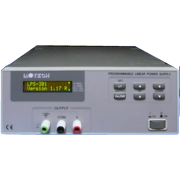Difference between revisions of "Motech LPS-300 series"
| Line 60: | Line 60: | ||
|} | |} | ||
The three-channel versions have the two main channels wired together for symmetric power supply, but the voltages can be set independantly, if desired. | The three-channel versions have the two main channels wired together for symmetric power supply, but the voltages can be set independantly, if desired. They can be set on or off only together. | ||
These specifications are common to all models: | These specifications are common to all models: | ||
Revision as of 11:52, 13 May 2014
The Motech LPS-300 series of programmable power supplies consists of 5 1-channel or 3-channel devices with optional RS232 connectivity.
The devices were also sold as the Amrel LPS-301 by American Reliance and partly under further brands.
Specifications
The models differ only in the number of available channels, maximum voltage and maximum current output:
| Model | Power Output | Channels | Voltage/Current |
|---|---|---|---|
| LPS-301 | 30 W | 1 | 30 V/1 A or 15 V/2 A |
| LPS-302 | 60 W | 1 | 30 V/2 A or 15 V/4 A |
| LPS-303 | 90 W | 1 | 30 V/3 A |
| LPS-304 | 70 W | 3 | ±30 V/1 A or ±15 V/2 A; 5 V/2 A |
| LPS-305 | 165 W | 3 | ±30 V/2.5 A; 3.3 or 5 V/3 A |
The three-channel versions have the two main channels wired together for symmetric power supply, but the voltages can be set independantly, if desired. They can be set on or off only together.
These specifications are common to all models:
| 30 V Channels | ||
|---|---|---|
| Voltage | Current | |
| Programming Resolution | 10 mV | 1 mA |
| Programming Accuracy | 0.05% + 20 mV | 0.15% + 5 mA |
| Readback Accuracy | 0.1% + 20 mV | 0.2% + 5 mA |
| Ripple (10 Hz to 20 MHz) | 1 mV rms / 10 mV p-p | 10 mA rms |
| Load Regulation | 0.001% + 1mV | 0.01% + 1mA |
These specifications apply only to models having a 3.3V/5V output:
| 3.3/5V Channel | ||
|---|---|---|
| Voltage | Current | |
| Ripple (10Hz to 20MHz) | 2 mVrms / 10mVp-p | 10mArms |
| Load Regulation | 0.001% + 1mV | 0.01% + 1mA |
The devices can be calibrated easily requiring nothing but a multimeter of sufficient precision.
Protocol
The communication with the device is via an optional RS-232 port (Option 02). The port parameters are 2400 Baud, 8n1.
All commands are plain ASCII. All commands are terminated by \r, \n or \r\n. Another command sent before reception of the reply (usually OK) will be ignored. It seems that trailing digits for numerical parameters can be left away.
| Commend | Reply | Description |
|---|---|---|
| BEEP(0|1|2|3) | OK | Beeper function 0: disable; 1: enable; 2: force alarm 3: off |
| CALI(0|1|2) | ? | Calibration 0=end; 1=begin; 2=input parameter There seem to be no plausibility checks and the description is incomplete. Messing around with the calibration is strictly discouraged and can cause odd behaviour! |
| HELP | (see right) OK | Output list of commands (several lines) |
| IOUT(n) | d.dddd OK | Current readback |
| ISET(n) d.dddd | OK | Set output current |
| LOWA(0|1) | OK | CC output compensated 0=off; 1=on (what is this?) |
| MODEL | \r\nLPS-␣␣␣␣ OK | Get model number (reply seems to be incomplete, bug?) |
| OUT(0|1) | OK | Disable/enable output. OUT without a parameter seems to disable it. |
| STATUS | <decimal> OK | Working status, bitwise encoding. Bit 0, channel 1 mode: 0: CV 1: CC. Bit 1, channel 2 mode: 0: CV 1: CC. Bit 3,2, tracking: 00: independant; 10: to channel 1; 11: to channel 2. Bit 4, digital output 3: 0: off; 1: on. Bit 5, digital output voltage: 0: 5 V; 1: 3.3 V. Bit 6, output 1/2: off; 1: on. Bit 7, output 3: 0: ok; 1: overloaded. Bit 8, Fan: 0: off; 1: on Bit 9, beeper: 0: off; 1: enabled Bit 10, CC output compensated: 0: off; 1: on |
| TRACK(0|1|2) | OK | Tracking 0=independant; 1=from channel 1; 2=from channel 2. Tracking seems to mean that channels 1 and 2 are synchronous on multi-channel models. |
| VDD(0|3|5) | OK | Set ("digital") output 3 0=off; 1=3.3 V; 5=5 V |
| VERSION | \r\nVer-1.17␣\r\n OK | Get version number. |
| VOUT(1|2) | dd.ddd OK | Voltage readback |
| VSET(1|2) dd.ddd | OK | Set output voltage. Entering more than 3 post-dot digits will overwrite starting from the left! The specified resolution is 10 mV. However, the actual resolution seems to be slightly higher, possibly due to rounding during decimal to binary conversion or depending on calibration. |
| * | \r\nERROR\r\n OK | Error (invalid command). |
OK means \r\nOK\r\n.
